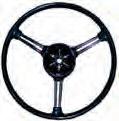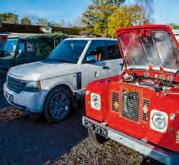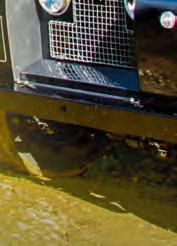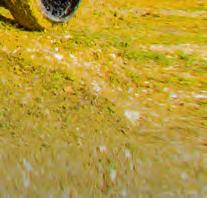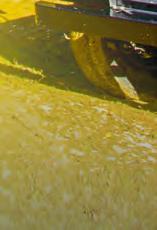Page 17: Legacy Overland’s

















































Page 17: Legacy Overland’s
















































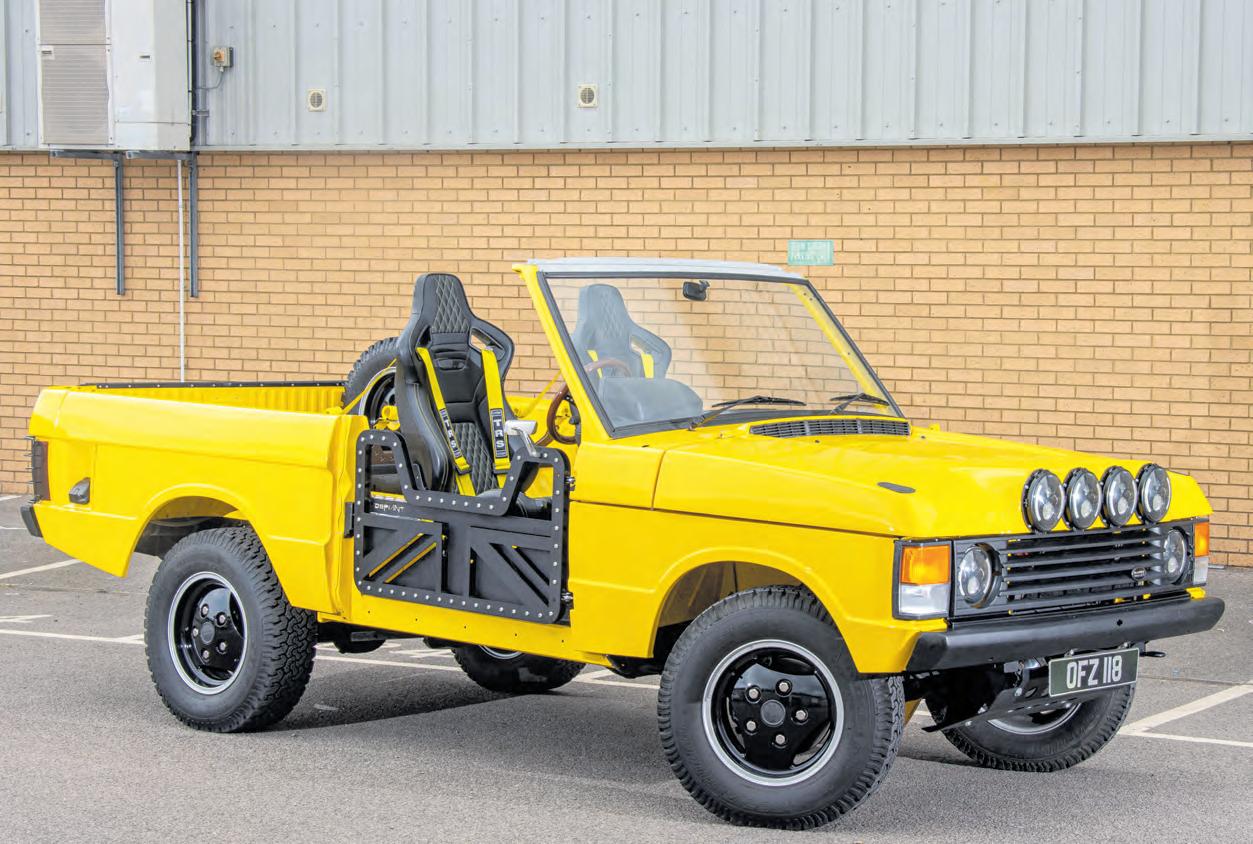








The Range Rover Huntsman had no roof and a starring role in the Bond movie Octopussy. This, meanwhile, is Neil Naranjo’s Defiant Huntsman. It started life as a Suffix B but then became a 1990 Vogue. Which in turn started life with a roof. But however it looks, this is not a Range Rover with the tin top removed… Full story: Page 23





















LAND ROVER HAS INTRODUCED
A FACELIFTED VERSION OF THE NEW DEFENDER. You might need to look hard to spot them, but there are details updates around the exterior including new front and rear lights – as well as the inevitable wheel designs and paint colours.
Inside, the highlight is a new 13.1” infotainment screen – though again, there are various other details waiting to be noticed if you’re sufficiently sharp-eyed. The gear selector has been repositioned on the dash, while down below the floor console combines a large stowage area with a hidden section for smaller items. Optional side pockets are also available, as is a cable management system so you can charge multiple devices without feeling like you’re driving a self-propelled
bowl of spaghetti. Sorry, truffle-infused artisan maccheroncini; this IS the new Defender, after all.
But it also still is a Defender, so you can still opt for the centre seat instead of all that to take it back to the three-abreast style of the original. And talking of the Defender, what’s this?
‘For those venturing off-road, Defender is now available with optional Adaptive Off-Road Cruise Control for the first time. The technology is an evolution of All Terrain Progress Control and allows the driver to set a desired comfort level when negotiating rough terrain, so they can concentrate on steering the vehicle – improving composure off-road while reducing driver effort. The system automatically adjusts the speed to maintain the desired level of comfort over undulating surfaces, for unruffled

off-road driving.’ NOW you can see why the old one never caught on. Going back to those headlights, these provide a new signature shape when illuminated. Between them, a gloss black grille bar becomes standard, while at the back you now get flush-fitting tail lights with a dark tinted finish. Further exterior updates include new front and rear bumpers with ‘optimised surfaces’ in a choice of silver or grey satin finishes, as well as a new textured pattern for the bonnet inserts and side vents and new gloss black Defender-branded wheel centre caps. Talking of wheels, you can also now get 22” diamond-turned seven-spoke alloys with a dark grey finish. And the greyness continues with the new Borasco Grey metallic paint colour, which is named after a silver mine in California. Woolstone Green, on the other hand, takes its name from a waterfall in the UK (right next to one of the sections of the Ridgeway that were closed to 4x4s by the House of Lords, which seems appropriate as it ‘recognises the British outdoors’.)
There are specific updates for the Defender Octa, too, including a new Textured Graphite exterior finish with





























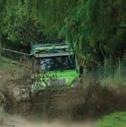







Phosphor Bronze on the front and rear bumpers, bonnet vent inserts, wing vent surrounds and bonnet script. Options now include a new Sargasso Blue paint colour and Patagonia White matte wrap, as well as carbon fibre exterior and interior accents, four interior treatments and 20” forged alloy wheels.
If you really can’t get enough of the carbon, you can spec an optional winch with the material on its cover. Further new accessories include fixed and deployable side steps and, on the 130, an integrated air compressor. You can also now get the existing Expedition Roof Rack, cross bars and front undershield in black, and a dark finish is also added for the rear scuff plate.
‘More than five years after its introduction, Defender has become an enduring success,’ says Defender boss Mark Cameron. ‘With a bloodline that can be traced back to the first Series I of 1948, Defender continues to capture the imagination of our clients.
‘The range now includes everything from a Hard-Top commercial to the epic Defender OCTA. With production at full

capacity to meet demand, the latest changes are part of our continuous commitment to make adventures even more satisfying.
‘Fresh design enhancements, new colours and an expanded range of accessories follow Defender’s comprehensive upgrade last year, ensuring our iconic 4x4 is better than ever.’
It’s hard to believe that the Defender has been around long enough to warrant a facelift, let alone a follow-up one. But that’s what happens when you’re

working on Defender time. The old one was still a couple of years away from even getting called the Defender by this point. But it’s already more than half a decade since the first vehicles started arriving in Land Rover’s dealerships –and most mainstream car makers are planning for a complete new model after seven or eight. So what this shows is that even if it’s not going to last as long as the original, the new-generation model is going to be around for a good while yet.
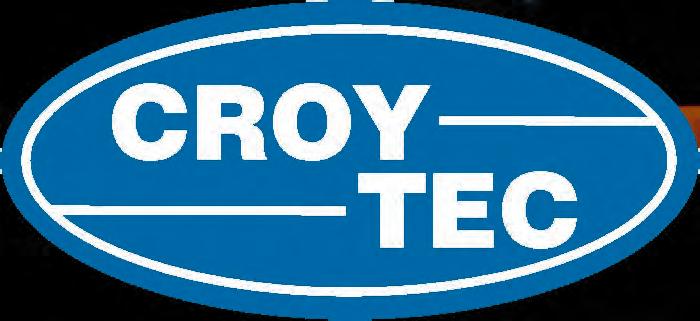




We give form to our components by machining detail into them with chamfered edges and rounded corners, under cuts, engraving and much more. We take time with care and attention to detail to ensure we deliver quality products. Our products have become a feature to many Land Rovers worldwide.




Alongside our aluminium interior and exterior trim range, our Special Order Service offers leather trim which can be designed to your requirements incorporating our colour anodised parts, to give you the ultimate Enhanced by Croytec Defender.


THIS EXTRAORDINARY PICTURE IS OF A GREEN LANE. You can barely see it under all the trees, but this is the Roman road through Crychan Forest in Wales following Storm Darragh – which battered the west of the country with winds of up to 95mph.
The result for the green lane network in Wales was that many rights of way were blocked by fallen trees. In a working forest like Crychan, the consequences were always going to be particularly spectacular –and whereas the majority of lanes were cleared by individuals or small groups of laners on days out, here it was necessary for heavy equipment to get involved.
Taken in February, the picture shows something in the region of 16 trees down across the right of way. With a harvester required to shift them all, the Green Lane Association (GLASS) contacted Natural Resources Wales (NRW), which promised that the work would be completed by the end of April – an undertaking on which they did indeed come good.
The Association’s Carmarthenshire Rep Andrew Hadley said he had found that unlike in some parts of the country when things go wrong, the local authorities were on the case quickly. ‘The council and NRW are doing as much as they can with their limited resources to get the network fully open again. Please continue to report any issues you find through the council website.’
While this was a natural phenomenon rather than anything sinister, the incident illustrates the importance of having an organisation like GLASS to look after green lane users’ interests. There are many local authorities that would have seen this as a heaven-sent opportunity to close the lanes for as long as they could get away with; Carmarthenshire is not like that, and nor is Natural Resources Wales, but it’s very hard not to feel that individual green laners, however many of them, would have struggled to get the damage cleared so quickly and effectively.









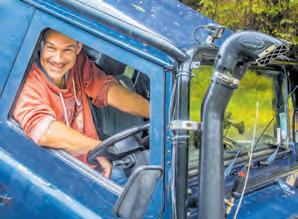
As we all know, the Defender has been a monumental success since Land Rover brought it out in 2020. It’s become the definitive example of the so-called Rugged SUV trend, at least in Britain, and there are loads and loads of them on the roads.
For Land Rover’s halo vehicle to have been such a smash hit is a big deal. But it’s not all good – because no small amount of the Defender’s sales have come at the expense of the Discovery.
Compared to the first four Discos, the fifth-generation model we have now is a relative rarity. People tend to say it has become ‘another Range Rover’ – that it has turned its back on usability and is now going full-tilt for the luxury pound. But as I’ve said before in these pages, there’s more to it than that.
The current Disco is a very premium thing, that’s for sure. In its equipment and refinement, comparing it to the Range Rover is not out of order. But when you get to drive one after the other, you see that there actually is a huge difference between them.
It’s still a fantastically useful vehicle in all sorts of ways, too. But if you want a practical wagon, you now think of the Defender – and if you want a luxury wagon, you think of the Rangey.
That leaves the Disco stuck in the middle. It’s meant to be all things to all people but I suspect it comes across more as being neither one nor the other. When the new one comes out next year, Land Rover will have to find a way of giving it its own identity.
It’ll be premium, of course. But luxury alone won’t work. My feeling is that the Disco has to reinvent itself as a family car that’s really, really up for it. Kind of like how it used to be, back when the image Land Rover advertised was of it parked on a suburban driveway with mud dripping off it.

The arrival of the new Beach Day, Snow Day and Road Trip accessory packs is promising in this respect. Land Rover knows what it wants the Disco to be to people, and who it’s aimed at. Now it just needs to get the next one on the market at prices they can afford, and it could once again be a common sight.
Alan Kidd, Group Editor alan.kidd@assignment-media.co.uk






















Remember the Discovery? You know, that vehicle that started out as the Range Rover after the Range Rover and ended up as the Defender before the Defender? Well it’s still around – in fact there’s a sixth-generation model due in the next year or so, which can only mean it’s time for the special editions to start.
Hence the newly introduced Discovery Tempest and Gemini. These have been introduced at the same time as various specification enhancements and new wheel options across the range. Land Rover’s press release doesn’t actually say what the enhancements are, apart from that there are new 21” and 22” wheel colours and the Dynamic HSE gains three-zone climate control, but apparently they offer more choice and versatility.
Something else the press release doesn’t say is what the new editions will cost. But we’re canny old dogs and we can use the internet, so it’s £72,505 for the Gemini and £83,720 for the Tempest. Joining at the top of the range, the latter is ‘the most luxurious, comfortable and highly specified Discovery ever produced.’
What makes it so is something else they don’t really explain, but you get aluminium cabin detailing and an extended black leather packageinside, 22” alloys with copper lacquer and a choice of three paint colours, two of them grey. These contrast with a choice of copper or black gloss on the roof, and then the copper is used again on the wing vent, Discovery script and lower bumper inserts.
The Gemini, meanwhile, is ‘a thoroughly modern tribute to the ingenious design of the original 1989 Discovery.’ This doesn’t mean it comes with absolutely no rustproofing anywhere, but our first thought was that perhaps it’s going to have a nice duck egg blue interior.
No such luck, although you do get a cooled cubby box between the front seats as well as three-zone climate and Click & Go media holders for those in the back. Because the great outdoors is no substitute for Mr Beast. On the outside, a choice of six paint colours includes Sedona Red (a first for the Dis-


covery and unique to this edition) with a contrasting black roof. Once again, the roof colour extends downwards, in this case to cover the lower body cladding, front wing vents, grille surround and Discovery bonnet script.
There’s also a Gemini graphic on the B-pillar badges, treadplates and interior finishers, and the vehicle rides on new 21” split-seven-spoke silver alloys.
Our view is that it looks better than the Tempest, but you pays your money and you takes your choice.
Both the new models are powered by the D350 48V mild-hybrid Ingenium diesel, mated as standard to an eightspeed auto box driving all four wheels. You don’t get low range as standard, though – it’s part of the £1610 Advanced Off-Road Pack, which also includes Terrain Response 2, Off Road Progress Control and a locking rear diff. Coincidentally, a towbar (electrically deployable, of course) costs almost the same; the Disco will, as always, haul 3500kg in superb style.

Since we’re on the subject of options, Land Rover has also introduced a number of accessory packs. Sorry, ‘curated accessory packs.’ It’s like a warthog looking in a mirror and seeing a swan, honestly. These are called Beach Days, Road Trip and Snow Days, all of which sound like Traffic Jam Days in real life but let’s go with it.
Beach Days includes a collapsible boot organiser for buckets, spades and beach balls, plus bespoke sun shades for all the widows behind the B-posts, tailgate included. You also get a roof rack for those canoes, surfboards and bodyboards we all take to Skeggy, plus rubber mats to protect the carpets and deep-sided interior sand guards.
The Road Trip pack includes two seat organisers, a centre armrest cooler and an electric cool bag to prevent your picnic from turning into warm stodge. Up top, you also get cross bars and a roof box for still more luggage capacity (the Disco is already no slouch in this area) and the whole package is finished off with wind deflectors for those blissful occasions when fresh air beats climate control.
Finally, Snow Days is about winter sports (and, therefore, long journeys). Cross bars are included once again, this time for your skis and snowboards, then there’s a rubber loadspace mat, mudflaps and a ‘snow traction system’ which we assume means a set of chains or something similar.
Land Rover says these have been introduced following the popularity of its existing For Dogs and Biking Adventures packs. However much it has been turned into a luxury car, the Discovery is still an incredibly practical vehicle
with the potential to be specced with a huge amount of capability – and even if Land Rover makes us grind our teeth when it described them as being ‘curated’, packages like these really do make the most of what’s best about it.



Not to be outdone by the full-size Discovery (see previous page), the Disco Sport has also gained a pair of new special-edition models.
Called Metropolitan and Landmark, these play on the luxury and versatility themes to make the most of the vehicle’s multi-faceted character.
They come as part of a revised model line-up in which the only other choice is the Dynamic S. The range of engine options continues as before, with D165 and D200 48V mild-hybrid diesels plus a petrol plug-in hybrid.
The Metropolitan is the new flagship in the Disco sport range, with silver finishes to the grille, undershields and bonnet badging as well as Metropolitan branded treadplates and new 20” alloys with a choice of colour finishes. Inside, you get leather seats with 14-way electric adjustment, heating and cooling, plus a premium stereo, cabin air purification system and camera-based rear view mirror.
If that sounds to you like a whole lot of not very much for something that’s
supposed to be an ‘edition’, the spec list on the Landmark model is positively zen-like. You get slide and recline rear seats, a panoramic roof, Click & Go media holders in the second row, roof rails and a 3D Surround Camera, while the treadplates and puddle lamps feature a version of the mountain range graphic that was used on the original Discovery back in 1989.
Finally, the Dynamic S has a load of black styling to give it ‘a dynamic and purposeful look.’ This would appear to be the entry-level model in the new range, as Land Rover says ‘every Discovery Sport – including Dynamic S – features a digital instrument cluster and steering wheel-mounted gearshift paddles as standard, while the centre console has an elegant floating 11.4” curved glass touchscreen.’ Prices start at £45,440 OTR; Land Rover’s website hadn’t been updated to include the new models when we wrote this, but by time you read it you should be able to get on there and see what the full works will set you back.






















mick@clutch-specialists.co.uk









inc VAT www.designdevelopmenteng.co.uk

THE 2.7 AND 3.0 TDV6 ENGINES ON THE DISCOVERY 3 AND 4 were lovely things when they wanted to be. But when they didn’t…
The camshaft timing pulley is one of the major failure points on these engines. So if you can replace yours with one that’s made right, the truck will spend more time being a lovely thing and less being just a thing.
This is where Design and Development Engineering come into it. The company designed its uprated pulley to eliminate the known problem of failure in the original part, with increased strength around all the fixing points, and manufactures it in-house using billet steel rather then cast and finishing it in corrosion-resistant black oxide.
The pulley is supplied along with a Genuine Land Rover dampener and the correct bolts for installation. Design and Development Engineering warns that the full kit must be fitted to guarantee the quality of any repair.









































































































Price: £19.98 - £59.99
LATEST ADDITION TO THE RANGE OF HANDY STUFF FROM RING is the Ultrainflate line of tyre inflators. This includes three models to suit all levels of demand and pricing, all of which promise intuitive operation and have large display screens, LED lights and valve cap storage. The three models are:
Ultrainflate 10
The entry-level tyre inflator in the range, this is intended for simple and efficient use with a large analogue display, ergonomic design and easily located power and light buttons. It has a 3m wind up cable and built-in 12V plug storage, plus an integrated LED light to aid visibility and a 60cm long hose allowing use on large wheels.
Ultrainflate 20

The mid-range model in the range, this builds on the capabilities of the Ultrainflate 10 by adding a programmable auto-stop function and a large digital display containing a progress bar to let users to track the inflation process.
Ultrainflate 30

The premium model in the range, this is designed for speed and ease of use and can inflate a 13” tyre from flat to 30psi in just two minutes. Not that you’ve got any of those on your vehicle, but it’s a good guide of what the unit can do. Its cable and hose are longer, at 3.5m and a 70cm respectively, and the latter has a large brass connector for a secure fit. You get the same auto stop technology as the Ultrainflate 20 (Ring calls it ‘Ringtelligence’), as well as the largest digital display screen in the range. This also features the same ‘Dynamic display’ progress bar, however instead of plus and minus buttons for setting the target pressure it has an ‘Easyset’ dial, making it even more convenient to use.
‘We’ve done a lot of research on this new range to ensure it includes everything a driver would want from a tyre inflator,’ says Ring’s Marketing Director Henry Bisson. ‘It’s easy to use, simple to understand, doesn’t take too much time to inflate and it’s stress free to put back into a storage bag or the box it came in.
‘Tyres are the only point of contact a vehicle has with the road and should be looked after a lot more than they are. We have found during our research that people are not checking their tyres enough.
‘With this new Ultrainflate range, and how quick and easy it makes checking and inflating tyres, we’re sure motorists will be able to better look after their tyres.’

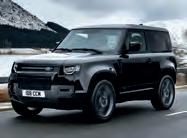


£475.00 plus VAT (pair)
IF YOU’VE EVER THOUGHT ABOUT FITTING YOUR DEFENDER 90 WITH MASAI WINDOWS but never been able to get the money together, now might be the time. That’s because Rimmer Bros currently have them on a clearance offer – albeit only for the 90, and end panel windows need to be purchased separately if you want those too.
The windows are made from 4mm toughened safety glass with a 70% privacy tint and promise to reduce heat and glare – as well as increasing torsional rigidity and providing greater security than factory-fit standard sliding windows. They’re leak-proof and draft-proof, too, which is definitely a novelty on an old 90, and a DIY-er should be able to fit them in a few hours – naturally, the kit comes with a fitting template and full instructions.

The windows include an aluminium inner frame and fit into a 1057mm x 427mm aperture – the standard size for Defender rear side windows. The price is for a pair, and kits are available for all pre-Puma 90s from 1983-on as well as for TDCi models up to the end of production.






































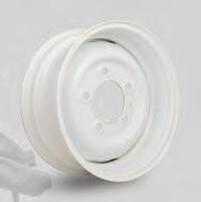







To advertise in The Landy, call our team on 01283 742969

We’re on Facebook: www.facebook.com/thelandyuk
‘Good
The value of old-shape Defenders may have dipped over the last couple of years, but people are still restoring them as enthusiastically as ever. There aren’t as many customers out there for mid-range restorations – however at the top of the market, the big money is still out there. This could easily lead to the resto game getting top heavy, the way it did with Series Is when Land Rover got in on the act and suddenly you were either a millionaire or the bloke with the spanners. But there are signs that in the Defender market, people have cottoned on to the fact that overrestoration is a thing. To put it another way, adding lots of bling is the way for a restorer to add to their margin, because every little bit of chrome or stainless they bolt on can be marked up. But more and more customers just want a nice 90 or 110 that’s been taken back to original, or original plus, without being turned into a tart’s handbag. We’re all familiar with the Defenders (and pre-Defenders, before anyone starts) that have been rebuilt into tacky horrors with an unlimited budget and no taste at all. There was a bit of a craze for it at around the time when Defender production was coming to an end, and of course there’ll always be at least some level of demand for the sort of more-money-than-sense Land Rovers created by a mercifully small number of specialists. But the vast majority of punters and experts alike have learned that making it look like a child’s toy on the outside and a 70s’ porn set in the cabin is no way to treat a fine old vehicle.
Legacy Overland has been restifying and re-engineering a range of 4x4s, Defenders included, since before that

in


craze ever started. And the alwaysimaginative US outfit has always been above doing anything so crass to the vehicles it builds.
This 1988 Land Rover 90 is a good example of that. It was built to be a really nice, modernised ‘Defender’ (inverted commas for the benefit of the pedants in the room) with a combination of creature comforts and enhanced off-road skills. In the company’s own words, the project ‘saw

the restoration take good and boost it to super.’
Right at the heart of this is the 90’s engine, a 3.5-litre Rover V8. Legacy Overland is not immune to using LS lumps when only a sea of cubes will do, but there’s just something right about a Defender with the venerable old Buick unit on board. This one has been completely rebuilt using Holley’s Sniper electronic fuel injection kit along with hydraulic tappets, a warmer cam

and a sports exhaust. The original radiator made way for a more efficient aluminium one, too, with an electric fan to suck the air through it. The engine remains mated to the correct LT85 5-speed gearbox and LT230 transfer case. Both were fully refurbished, as were the axles and indeed the chassis – it was all a bit crusty when the guys in the Legacy Overland workshop first stripped it, but despite needing some welding it
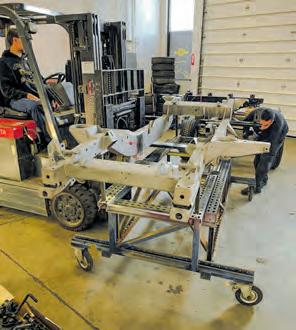
was fundamentally sound and able to go again in its renewed form. The suspension was renewed, as were the brakes – with the rear axle gaining discs – as the vehicle gained a new mechanical spec which would make it ‘sublimely drivable.’
There are those of us who would argue that all Defenders are sublimely drivable. Even if some of them verge on the ridiculous instead. But we know what they’re saying here – you always
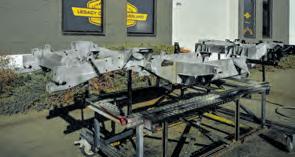



have to put the work in when you’re behind the wheel of one of these, but some of them give you more than others in return and this one is set up to give you a bit more besides.
It’s the same deal inside, where Legacy Overland’s trim crew have always been able to stay within the boundaries of good taste – but know how to do the good stuff better than the brothel-spec upholstery brigade. Just as there are people who put honking great engines into old Defenders and create things that are barely usable, there are those who’ll lob half an acre of ghastly bright leather at a cabin which still has the teeth marks in it from some old Yorkshire farmer’s dog. Safe to say neither approach has been involved here.
You might not call it understated but it certainly is restrained. The interior was built back following the full stripdown with sound-deadening material on the seat box, bulkhead, tub, wheel boxes, side panels and so on, followed by black leather trim with contrasting white stitching on the dash, cubby box and seats – two heated Corbeau buckets and four inward-facing jump seats, to be precise. The dash also gained a centre console which holds a cluster of auxiliary gauges and a bank of rocker switches for the heated seats, electric windows and central locking.
The dark theme continues with charcoal alcantara on the roof and walls, while further detailing inside the cabin includes aluminium pedals, gear knobs and door handles. The main gauges have ally bezels, too, and the steering wheel has stainless steel spokes and a matching wrap in black leather with white stitching around its rim. Around the body, you’ll see Optimill hinges, KBX vent covers and so on –and of course having been prepped for paint, the panels were finished in a deep grey glory coat.
What we’ve not mentioned yet, though, is the kit that’s gone on to make an off-roader out of it. Which is more extensive than you might expect, even if 275/65R18 is unlikely to be your first choice of tyre on a 90. Those tyres are Cooper Discoverer STT Pros, however, which immediately gets a thumbs-up from us – and even if there’s more wheel and less sidewall than we’d go for ourselves, there’s no denying that they look the business filling up the space beneath the Defender’s arches.


Something we definitely like to see is the sort of winch you can rely on, and a Warn Zeon 8 certainly ticks that box. It’s tucked in beneath a deformable A-bar and in front of the condenser for a bespoke air-conditioning system, and beneath it the bumper mount flows down into a heavy-duty steering guard. Moving back along the vehicle there are jackable rock sliders, too, as well as a NAS rear step – and up top a steel snorkel helps keep trail dust out of the engine’s air intake. And water,

should the 90’s owner decide to take that particular risk.
We can’t see that happening, though. Because capable though it is, this is a 90 that’s way too nice to trash.
A year and a half on from when Legacy Overland started pulling it apart, the company was ready to show it to the world – and a very happy new owner was ready to and start enjoying the fruits of a proper restoration.
So is the resto game getting top heavy? After all, a job like this doesn’t
come cheap. Well, classic cars have never exactly been a poor boy’s pastime – and as always, if you want it done right you needn’t expect it to also be done cheap.
So yes, this is a premium build – but it’s certainly not the kind which, for a while, threatened to give the Defender business a bad name. It’s built to be used and it’s built to last – exactly how any real off-roader should be. And not even a whiff of bad taste. Good boosted to super? Check.


Heritage 1948 are proud to introduce there all new wheel
The Culbone Dusk is our rst wheel to feature our exclusive Gun metal grey body. This premium 15 inch Hand stitched leather steering wheel has been designed for the Land Rover Defender and is crafted for durability and comfort, it’s thick robust rim ensures a secure grip in any driving environment, whether


Heritage 1948 is dedicated to producing a range of outstanding quality canvas Hoods for Series Land Rovers. Unlike some of our competitors, all of our Land Rover hoods are handmade in our Somerset factory from superior quality ‘Moorland’ canvas.

£348.50 (Including Boss Kit)
The Heritage 1948 range of classic Land Rover Hood Sticks parts has been developed to be the most accurate reproductions on the market. Unlike many of our competitors who produce their hoods sticks abroad, all of our hood sticks are manufactured right here in the UK.
Our handmade Hoods are inherently more accurate than machine produced counterparts allowing for an enhanced t and exceptional quality control.
Heritage 1948 has taken great care to ensure all our Land Rover Hoods have an enhanced life span and are all nished with period correct Solid Brass ttings.

your Landys on rugged trails or city streets. Meticulously designed and built with the craftsmanship synonymous with Heritage 1948. The gun metal grey is set o against a classic three-spoke design, enhanced by clean, crisp slots, adding a timeless touch to your Defender’s interior. +44

Shaped by hand operated tooling in the same process the original parts where manufactured, we have selected a high quality steel and low volume galvanising to produce the most accurate period correct Land Rover Hood Stick sets on the market. £565.00








































Land Rovers are returning to Newark Showground this August for a day filled with Land Rovers!
Exhibitors old and new will join us, selling everything from parts & accessories to tyres, clothing and toys Talk to overland adventure specialists about your next trip, discuss modification options with companies with the know-how and other experienced Land Rover owners.




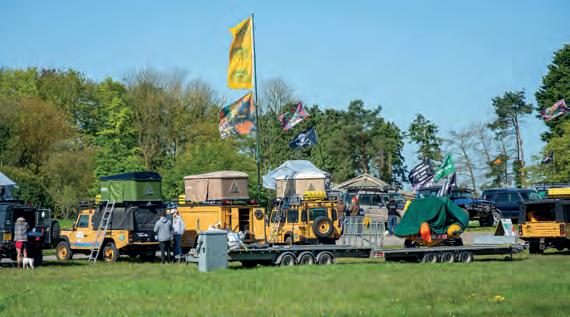













Part NumberDescription Details
TF972 Roof Rack 2.2 x 1.0m / Steel Tubular
TF973 Rear Door Access Ladder Discovery 3 / Discovery 4
TF1714 Terradactyl 2/5 LED Awning 2.0m / 270 degrees / 5 Wing
TF1740 Portable Power Station500w Output
TF1741 Power Panel 100w / 2 section solar panel
TF1722 Camping Table 70 x 70cm / Aluminium
TF1720 Camping Chair Heavy Duty / With storage bag
TF1721 Marshal Stool Folds flat for storage
TF1211 Water Bottle 660ml / Stainless Steel
TF1212 Travel Mug 600ml / Stainless Steel
TF1213 Water Bottle CarrierInsulated / With Shoulder Strap
TF1730 Fire Pit Stainless Steel
TF1726 Expedition Shovel 1.3m handle
TF795R Dry bag 80 Litre
TF794B Dry bag 10 Litre
TF902 Expedition Storage Box 160 Litre Capacity


Whether you’re embarking on an off-road expedition or packing up the kids for a summer camping trip in your Land Rover, having the right gear makes all the difference.
Prepare for your next camping adventure with high-quality, purpose-built gear that ensures a smooth and stress-free experience—wherever the road takes you!



To advertise in The Landy, call our team on 01283 742969

We’re on Facebook: www.facebook.com/thelandyuk

People have chopped the tops from Range Rovers before. Neil Naranjo’s tribute to the roofless Rangey from the Bond film Octopussy is a bit different – in that it didn’t really have a body worthy of the name to relieve of its roof in the first place

Words: Olly Sack Pictures: Alan Kidd
You might assume that Neil Naranjo’s Range Rover has had its roof chopped off. People ask him that all the time – but no, actually, it was built this way from the ground up. Not in Solihull, obviously. The market for a Rangey that gives you frostbite on winter mornings would be less than brisk (Neil’s been there, done that and won’t be doing it again…), after all. But its owner is a draughtsman and fabricator, so a vehicle whose body was largely absent was simply a perfect opportunity to make his own.

‘Growing up, I was always around cars,’ reminisces Neil. ‘I was always going to be a petrol head from the start. Specifically 4x4s and American stuff, though, never supercars or anything sporty.
‘I never belonged to one stable when it came to 4x4s. I’ve preferred to drive underdogs at off-road days. But Range Rovers have that shape I remember seeing as a kid and liking straight away,
Left: The doors were a virtue born of necessity in that an original pair was going to cost an arm and a leg. Inspired by something he’d seen on a Jeep, Neil put his professional skills to good use in making a set of safari-style half-doors – complete with Union Jack detailing
Right: Quilted leather seats, woodrimmed steering wheel… it’s not a spartan interior, this. Not that you’d want to go very far in it on a cold winter’s day
and I’ve saved and owned many over the years.’
This latest example is a 1990 Range Rover Vogue. Well, that’s what it is now. But this is a project that took a massive twist mid-way through –saving an early classic in the process.
‘Going back to early 2021,’ recalls Neil, ‘an old pal said he had a 1973 Range Rover Suffix B requiring “light restoration.” By “light,” he meant there was a chassis, engine, transmission, axles and bulkhead, plus the remnants of the light boxes and some bits


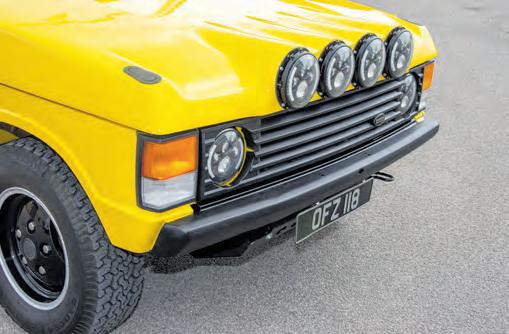
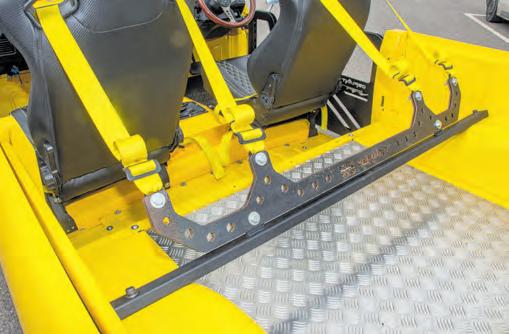
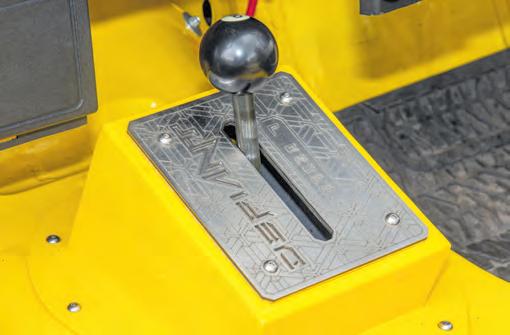
We like it when people make things. We like it when they look cool and we like it when they do their job, and we particularly like it when they look cool and do their job. This is definitely the case with the Qt-esque light pod on the bonnet, which gives the Range Rover a distinctly race-bred image. So too does the harness anchor bar behind the seats – even if the etched plate around the 8-ball tranny shifter looks more like it belongs on a six-figure resto-mod than a comp safari beast
hanging on round the back. There wasn’t enough to build an original on a limited budget, so it was always going to be a stripped down version of something.’
That something was the Huntsman, a topless Range Rover which starred in the James Bond film Octopussy. Neil started by stripping away the engine, transmission, axles and bulkhead (what was left of it) to leave just the chassis, which was then shot-blasted to reveal just how bad it was. Many people would have gone shopping for a new galvanised unit and started afresh with that, but since he knows what he’s doing with this stuff he patterned and laser-profiled fresh steel instead which he used to repair the original. With the axles rebuilt and refitted to give him a rolling chassis, and yet more serious metalwork done to restore the bulkhead, Neil started building the new body. Front inner wings, inner and outer sills, floor panels and rear uprights came from GDI in Coventry, the tunnel and step behind the seat boxes were ‘a very lucky eBay purchase’ and the A and B posts came all the way from Australia. ‘Bit by bit, scouring the internet, meeting like minded people along the way, I gathered as many parts as possible.’
Which brings us to the roof. ‘After seeing a certain James Bond movie,

If you’re wondering where the yellow paint came from, keep wondering. You won’t find it on any colour chart, says Neil – who pressed his own Dad into service to do the spraying, with outstanding results
I decided very quickly to omit any roof structure at all. As with many things on this project, availability of parts, budget and wind direction steered things towards what you see today. The doors, for instance: three-door Range Rover doors are very expensive, so instead I fashioned and installed a set of home made “safari” doors.’ Note the stylised reference to the Union Jack in the bottom half of his design.
Now, all this time Neil was still working on the Suffix B Rangey his mate had sold him. And it won’t have escaped your notice that a Suffix B and a 1990 Vogue are not the same thing.
Fundamentally, Neil is a man with the skills and the vision, not to mention the equipment, to build a radical oneoff. But he had been buying an awful
lot to replace the rotten bits of the old ’73 – and what the project needed over and above that was more funds.
This is where his decision to restore the Suffix B chassis, rather than tossing it in the scrap bin and go galvanised instead, turned out to be a very sound one. And, to be fair, one that was probably never in doubt.
‘A mint condition suffix B chassis has a value,’ he says, ‘and the project did need an injection of cash. And I did have a one-owner, 90,000-mile, full service history 1990 Range Rover Vogue awaiting restoration behind the scenes that was in pretty bad shape.’
You can see where this is going. Neil decided to remove the body from the Vogue (only three of the mounts were left intact, so he could just about
have done this with a hearty sneeze) and replace it with his newly fabricated open-top body. That left him with a good-as-new Suffix B chassis to sell – which he did, to no less a customer than Kingsley Cars. This is a company which comprehensively re-engineers early Range Rovers to modern standards, so the ’73 chassis was destined to go beneath an extremely exclusive vehicle.
What all this also gave Neil was a set of exterior panels from his 1990 Vogue. Including a roof, you may note. No, not likely. He was on a mission now.
‘Decent original exterior panels are hard to come by,’ he says. ‘Longranger supplied a set of new fibreglass rear quarters, the front wings are plastic, the bonnet was another lucky eBay
purchase and the very rare fibreglass tailgate was from a friend – but he took some convincing to sell it!’ He ought to approve of the use it went to.
Now it was time for Neil to hand over parts of the project to people he could trust. And who in life can a man trust more than his dad? That’s who painted all the panels (‘just as he was retiring,’ admits Neil) in a shade of yellow you won’t find on any colour chart.
‘Yellow has always been my favourite colour, but there is a time and place for it,’ he says. You can’t imagine a standard, full-bodied Rangey in this colour, for example. ‘As the Range Rover took shape, it became clear that yellow was the only colour to use. It’s bright, fun, chilled, perhaps unserious even. Much like this car!’

To advertise in The Landy, call our team on 01283 553244

We’re on Facebook: www.facebook.com/thelandyuk
Before that, since the vehicle’s mild steel skeleton was basically from the early seventies it could all be taken apart nice and easily. So Neil did exactly that one more time and for ease, protection and cost he sent it off for powder-coating. ‘Yes, we powdercoated a car!’ Not just a component here, a bumper there, the whole frame. Range Rovers follow different rules to the rest of the world…
In addition to his dad, Neil shouts out an old friend who handled all the wiring – as well as various other people who ‘I hassled into helping me at various points.’ It’s rare for a project to be all about just one person – though despite this, the Range Rover is still very much Neil’s own vision brought to live by his own hands.
‘I don’t travel too far in it,’ he says. ‘You have to guarantee the weather and secure parking, but I go to shows with it and I use it for the short journey to work sometimes.
‘I like it because it’s a one-off, it’s unique, and it had its own character. It screams fun and enjoyment. It’s not a daily, or a family car – I can’t even go shopping in it. It’s only purpose is to be driven on warm, dry days and put a smile on your face – and anyone else’s who sees it!’ Just like that Range Rover in Octopussy, then…
Neil’s Range Rover will be appearing in the Big Yellow Car Show, at Cheshire Showground on 5-6 July



n Access from 3pm on Saturday 5th July
n Driver & All Passengers Get in Free
n £1 General Yellow Cars
n £10 Grouped Yellow Display Vehicles
n Grouped Display Vehicles must be booked in advance

www.thelandy.co.uk
Issue 142: Aug 2025



n Access on Sunday 6th July 10am-4pm
n Save 20% when you book in advance
n £8 per adult | £4 per child (5-15)
n (On the Gate £10 per adult | £5 per child)
n Free parking
n Under 5’s go free
n Dogs on short leads welcome


Real ale and cider tent | Street food vendors and food court | Picnic area Shop from our many stalls selling everything from car accessories, camping equipment, gifts and novelties | Children’s inflatables and activities



Thousands of yellow cars are coming together for the biggest gathering of yellow cars on record. Bear witness to the spectacleit’s bound to put a smile on faces young and old alike!
Take a look around our groups of display vehicles, including Super Cars, Classics, 4x4s and Custom Cars. And look out for some famous cars and faces you just might recognise.






all Land Rovers. Its engineering and design give it real charisma, but parts aren’t readily available. Restoration projects require deep pockets, but see it through and the result will be worth mega bucks.
The Series I, particularly in its 80” guise, is the most sought-after of

Gone are the days where you could use a Series I as an actual Land Rover. Because with restored examples changing hands
£5000-£85,000
for millionaire money, preservation is the aim of the game.
The earlier the vehicle, the more it will be worth. The sky’s the limit – but can you really put a price on such an icon?
Pros: Heritage, charm, a true classic, the original Land Rover Cons: Availability of parts, price tag on early 80s Series I (1948-1958)
Cons: Not yet as desirable as the earlier Series models Series III (1971-1985)
terms, keeping the same 2.25-litre engines throughout the length of its production run. In 1980, the engines switched to a more durable five-bearing crank rather than the old threebearing setup. The transmission also received syncromesh on all forward gears to make it easier to live with.

£2500-£35,000
They still carry the simplicity of earlier Land Rovers, but the Series III remains the most affordable way into owning a leafer.
Pros: Most affordable route into Series ownership. Still has the Series pedigree. Parts still widely available
Lightweight (1968-1984) £3500-£22,000

These military vehicles can easily be distinguished from regular


Land Rovers. To mimic the civvy Series machines, the Series III model built from 1972 onwards, also had its headlights switched out to the wings.
Lightweights add an extra dimension to owning a Land Rover. Their military history and details mean you get a truck with more stories to tell – and that stands
Early
These
Rovers
coilsprung suspension, new engines and a world-beating level of rugged off-road capability.
out from the crowd. They’re a rare breed, though – so if you’ve got one, it’s worth keeping hold of.
Pros: Not like all the other Land Rovers out there. Military background. Lovely 2.25 petrol Cons: Appearance isn’t to everyone’s taste. Exclusivity over regular models means they command a price premium
Don’t be fooled by high prices. Values have dropped in the last two years, and only a real rarity in pristine nick is worth the money that used to be commonplace.
Pros: Excellent parts availability. Easy to work on. Unlimited potential for mods and restos
much of that early charm. Prices seem to have peaked now, however they still remain strong for good examples.
A 2.25 petrol 88” would be our pick, as the diesel engines were underpowered and rather noisy.
refinement. While the engines have excellent longevity, they need to have been maintained properly. Be thorough in your checks, both under the bonnet and underneath the body.
refinement, but this is seen by many experts as the best Defender of them all.
The LT77 gearbox in the 200 Tdi is more truck-like than the later R380, and these vehicles didn’t come with bling. Just be sure it’s an original Tdi you’re getting, not an old Discovery conversion.
Pros: The perfect combination of tradition and modernity
Cons: Lots of horrible and/or deceptive ones around
Cons: Bulkheads and chassis rot, springs prone to seizing Series
The Series II/IIA has a wider stance than its predecessor and adds an extra (thin) layer of

rarity – with all the cachet, pride and immense awkwardness that comes with this status.
By ‘rare’, we’re talking about less than 2500 Series IIA FCs in total. And they tended to have a very hard life, so not many have survived to tell the tale.
Pros: A sound investment to restore – and enjoy
Pros: A Land Rover like no other, if that’s what you want Cons: Especially brutal to drive, and to find parts Series IIA/IIB FC (1962-1971) £2500-£15,000
Forward-Control models differed from everyday Series IIs by

Only ever
the time came for demob. They were flogged off at very low prices and turned into off-road toys –not something you’d do with one today, given the rarity and classic value they’ve taken on.
having heavy-duty ENV axles, but engine-wise they had the familiar 2.25 petrol and diesel lumps. So, don’t expect performance – but do expect to be given an ‘interesting’ time in the workshop…
£7500-£26,000
Compared to the IIA/IIB FC, the 101 is more fun thanks to its V8 engine. It’s still a military tool, though – some still have fixtures and fittings from their Army life, which adds interest. This is a vehicle for enthusiasts, though, with costs that are sky-high even by Land Rover standards. Pros: Master of the road. Lovely V8 soundtrack. Everybody who sees one loves it Cons: Monumental running costs. Expensive to buy, too

The 127
work truck tend to go for a later 130, so the 127 is more of an enthusiast’s

motor. It’s popular for homebrewed overland conversions, too. Almost all 127s have had an engine conversion by now, too. Lots to be wary of, then – but it’s a hell of a lot for your money. Pros: Enormous size means limitless potential and character



The 300 Tdi engine is very different to the 200 unit it replaced, though
the two are related. It’s much more refined and smoother to drive, though there are more electronics involved so later versions in particular are less of a DIY fix.
The arrival of the 300 Tdi also brought with it the R380 gearbox. This used to have a terrible reputation for relability, but most have been put right by now and they’ve
£3500-£40,000
become sought after for their light clutch and better shift action.
It was during the Tdi era that Defenders started getting things like alloys, too. You might even find one that’s not been off-road… Pros: Strength and simplicity. Perhaps the definitive Defender Cons: Sure to be very different to when it left the factory
TDCi (2007-2016) £6500-£275,000

The last Defenders gained modern 2.4 and 2.2 TDCi engines and


smooth six-speed gearboxes, They still had phenomenal off-road ability and were even okay to sit in. Famously, this was the Defender that actually had a dashboard You can find special editions and boutique conversions to TDCi models that cost obscene amounts of money. You will pay a premium for any these late
It’s also a notable classic in its own way, as it heralded the start of the company’s modern era. It has its issues, though. The viscous coupling is expensive to replace and can be upset simply by running mismatched tyres. The 1.8 petrol used to be notorious for head gasket failures. Today’s replacements are much
are people who do just that, preferring to invest new-car money in a restoration than spending it on a current model.
It’s a smart policy, too. An early two-door can cost mega money, but any Classic will appreciate in value if kept in good condition –and sought-after rarities like the CSK and LSE can be a gold mine.

a strong performer. It does lend itself to being tuned though, so watch out for abused ones and knackered examples that have been pushed beyond the limit.
As with all Defenders, you’ll need a rear crossmember sooner or later – or even a new chassis.
still be a DIY machine. Parts are in plentiful supply, as is specialist knowledge – and it’s one of the best Land Rovers ever.
Defenders, however the era of skyrocketing prices seems to be over and TDCis have dropped further in value than the Td5. So a good 2.2. could now be quite a shrewd investment
Pros: Efficiency, creature comforts, off-road prowess
Cons: Price, electronics, TDCi engine is unloved
more robust, but a late diesel is your best bet. Even these can go calamitously wrong, though. This was a more complex car than it needed to be, and buying one for sweeties now doesn’t change that.
Pros: Cheap to buy, no big rust issues, surprisingly able off-road Cons: All sorts of things can go wrong, some very expensively
An awful lot of Rangeys have been neglected and/or abused, and you can still buy they cheap. But if you’ve got the skills, and access to parts, restoring one would be the ultimate hobby that pays.
Pros: Most usable classic Land Rover, V8 power, ride quality
Cons: Rust, availability of parts for early models
Range Rover (2002-12) £2200-£24,000

The Mk3 Range Rover hit new
of luxury and was more reliable than the P38. It’ll still cost a lot to run, however, and drivetrain faults and underbody corrosion are not unknown.

The TDV8 engine is sublime, but you’ll pay more to get one –especially the 4.4, though the 3.6 has all the power you need. The V8 petrol, on the other hand, is temptingly cheap. Guess why…
This isn’t a DIY motor, but it certainly is a Range Rover, with brilliant off-road and towing skills. It relies a lot on electronics, but they work wonders – and the deepdown engineering is very robust.
Pros: Great off-road, luxury, image, TDV8 powerplants
Cons: Very complex. Huge running costs
The Td5 engine is arguably Land Rover’s most reliable unit and it’s
Despite having more electronics than the Tdi, a Td5 Defender can
(2020-on)

If the subject of the new Defender comes up in enthusiast circles, try



The fourth-gen Range Rover is a majestic 4x4. All the engines in the

to steer it away on to something safer. Like Brexit, for example.
Much as it may infuriate purists, however, the Defender is actually a very wonderful thing. It’s kind of like an old one, only with space, comfort and equipment.
The big difference is that you can’t work on it yourself. This goes for maintenance and, crucially,
it replaced. It’s a refined and affordable SUV with a strong engine, good equipment and a decent level of practicality.
It’s become one of the most reliable Land Rovers out there, too.
But do be aware of the rear diff and Haldex unit for costly outlays.
The 2.2-litre diesel engine is a strong performer, though for a
own, even today. The problem is that they’re very complex and very, very good at going wrong. Air suspension failure is the norm. Head gaskets can let go. Electronics are laughably flaky. And parts can cost the earth – as will the labour bills. Perhaps worst of all, nowadays it’s very hard to find one you can be sure hasn’t
range supply copious amounts of power, and its road manners are absolutely impeccable.
It’s startlingly capable off-road, too, even if getting one muddy would feel like bad form. Most that leave the tarmac probably do so only when their owners are in the mood to blow some grouse out of the sky.
a supreme off-roader as well as
Pros: Off-road capability, power, overall reliability. Very well suited to being modified
Cons: Rear chassis, premium prices, monstrous road tax on later vehicles Defender Td5 (1998-2007) £3000-£35,000
£45,000-£185,000
making modifications – a market Land Rover wants to take back and have for itself. It won’t hold its value long-term the way an original-shaper does, either. But this is still a superb vehicle.
Pros: Comfort, capability, rugged fitness for purpose
Cons: Not cheap to buy. Lacks the old one’s basic charm
bargain search out one with the unpopular 3.2 petrol unit. Either way, it’s a fine SUV to drive. Prices have fallen since the production ended, too – £15,000 now gets you a late one on tiny miles.
Pros: Reliability, refinement, economy of diesel engine
Cons: Transmissions can wear quickly if used for towing
spent at least part of its life being worked on by idiots Still, you’ll get a classy motor with proper off-road and towing skills. It’s becoming a classic, too, and prices are still tiny considering everything you get.
Pros: Luxury, price, a Land Rover that doesn’t rust Cons: Electrics. Be very afraid
Inside, the Range Rover’s cabin is superb, with sumptuous trim and cutting-edge equipment. Prices are, of course, as immense as the vehicle itself. But if you can afford it, so too is the presence a Rangey will give you.
Pros: Class, luxury, engines, vast all-round capability
Cons: Price


The second-generation Range Rover Sport is 400kg lighter than

the original, meaning it’s almost economical to run. It feels really nimble and agile on the road, too, and it comes with a range of engines giving it a brisk turn of pace.
Some won’t like the flamboyant posture, while others will love it. Either way, inside the cabin it’s very nearly as luxurious as the full-house Range Rover.
£13,500-£65,000
If you can afford the SVR model, you’ve got a super-SUV with rap star image. In every case, though, running costs will be vast. Parts don’t get any cheaper because you bought it second-hand…
Pros: Performance, refinement, handling, glorious interior
Cons: Marmite image. Pricey to buy and run
Range Rover Sport (2022-on)

Hilariously, this is what counts as the affordable way in to owning a
new Range Rover. The Sport is less about being chauffeur driven and more about lording it over other aspirational school runners, but once again it’ll be lovely to drive.
Like the full fat Range Rover (a phrase which has never felt more appropriate), the Sport is available with an old-school V8 engine that gives you racecar performance in
£80,500-£145,000
return for NASA-level emissions. Most UK customers with opt for an altogether healthier plug-in hybrid, but they’ll still get a vehicle that’s brutally fast a well as being able to do the normal Range Rover stuff.
Pros: Smooth, refined, comfy… and game for a laugh, too
Cons: Still hasn’t quite shed its proceeds-of-crime image
When the Evoque was launched, it signalled JLR’s intent on hitting

and
Evoque (2011-19) £4500-£31,000
the masses. Given that it was the company’s fastest-selling vehicle, they clearly hit the brief, even if it wasn’t for the traditional Land Rover owner.
It’s actually still a capable thing off-tarmac – but it’s definitely more at home on the road. Nevertheless, it is economical by Land Rover standards and
because of its particularly handsome exterior. It’s based upon the same architecture as the Jaguar F-Pace but has greater off-road ability and is available with a wide choice of engines, most of which combine good economy with usable everyday performance.
because there are so many out there, used prices are tempting. There’s a Convertible model, too, as well as three and five-door tin-tops. We say stick to the latter, and be sure to get one with 4WD.
Cons: Cramped rear seats, not as practical as a Disco Sport Range
Pros: Economy, handling, iconic concept-car image

Evoque has adopted a similiar back end to the larger Velar. It’s not just the exterior that mimics the looks of the larger vehicle, however, as the Evoque has gained the latest Touch Pro Duo tech and a hike in quality.
The main highlight of the new Evoque is the fact the majority of the range is made up of mild
hybrids, available with diesel and petrol engines combining to an electric motor. Only the base D150 Evoque escapes the electrification, and we’d avoid it as it doesn’t have four-wheel drive.
Pros: Feels like a proper Range Rover inside
Cons: Petrol engine is poor on fuel economy, even as a hybrid
it came out. It was very much designed to be a trend setter. But is there a whiff of style over substance? Well, it’s a very good SUV. But you don’t half pay a premium for those suave looks...
Pros: Stylish design, chic cabin, excellent tech features
Cons: Feels like an indulgence, especially at such a high price Range Rover Velar (2017-on) £22,500-£85,000
The interior was Land Rover’s most advanced cabin yet when

most most reliable units ever. It drives well, too – mated to a manual box it has more guts even than the V8 option, which is surprisingly bland but predictably thirsty. Whereas the Disco 1 was prone to body rust, the D2 is fine here. Instead, its chassis rots like a carrot, especially towards the back end. Also at the back, seven-seat


a Discovery in name only.
It’s a more practical proposition than the closely related Evoque, and you won’t need to live with the fear of Posh Spice jokes.
models had air-suspension, with all the horrors that brings.
Mainly, D2 owners will tell you about rogue electronics. And leaky sunroofs. They still love their trucks, though, which says a lot.
Pros: Td5 power and reliability, great all-rounder, lots of choice Cons: Chassis rust, electronics, leaky sunroofs, air suspension

with the same 100” wheelbase and a slick body containing a spacious, flexible cabin. It was well equipped and refined, and it came with the wonderful Tdi engine.
There are some tidy deals to be had on late high-spec examples now – though if you do a

The Disco 3 is an astonishing allround vehicle.

Over time, the Disco’s epic ability meant almost all of them were hammered at playdays. Lower body rust is a big killer, too. So it’s rare to find a good one now,
and capable off-road, genuinely luxurious and a giant of a tow truck, and as well as being able to seat seven adults it can be turned into a van with a totally flat rear load area.
But it was also astonishingly complex, and these days it has a reputation as a money pit. Air suspension and electronic
and when you do they tend to be priced with a lot of optimism. Very early ones in tip-top condition are full-on classics, too. For a sound one to own, we’d look for a tidy 300Tdi.
Pros: Price, practicality, parts availability. Epic off-road ability
Cons: The body rusts like it’s been doused in sea water Discovery (1989-1998) £800-£15,000
handbrakes are big sources of woe, cam belts are a body-off job to change and rust is becoming more of an issue. Get a good one, though, and it’s all the car you’ll ever need.
Pros: Good at everything. Lots of accessories available now
Cons: The phrase ‘money pit’ crops up time after time

after the first. That’s because once again, it’s related to the Evoque, which was ready for a full new model in 2019.
The Sport is a premium midsized SUV with seven seats and a decent level of off-road ability. It’s a massively popular choice for the school run – and, with the arrival






LOWERING THE COST OF OWNERSHIP, WITHOUT COMPROMISING ON QUALITY
Manufactured to exacting standards to maintain your vehicle’s ride and handling.

PROEVO+ Steering and Suspension products are selected to meet the stringent level of performance & durability associated with Land Rover and Jaguar vehicles.









Series IIA 88” ST (1965). 2.25 petrol. Full resto some years ago. Recent body and paint. Army engine. Rocky Mountain springs. FHW, overdrive. Solid, runs well, all works. Many new parts. £10,450. Stone. 07984 167822 08/25/004

Defender 110 Td5 Camper with pop-top back (2003). 98,000 miles. Lift, snorkel, bull bar, galv belly pan, LEDs. Undersealed. Many new parts. Full respray. No rust. Mint! £17,995. Rowley Regis. 07961 795594 08/25/001



Series IIA 109” (1969). 2.6 6-cyl petrol. Recent nut-and-bolt resto costing £7000. New brakes, electrics, hood and sticks, exhaust, tyres. Mechanically superb, excellent inside and out. £12,500. Oundle. 07583 457511 08/25/007

Defender 90 200 Tdi ExtendedCab (1987). 103,000 miles. New chassis, discs, +3” lift 2-3 years ago. 33s. Rewired, bulkhead done, new PAS pump, heater, doors, exhaust. Long MOT. £11,750. Bury St Edmunds. 07900 991637 08/25/005


Series III 109” (1975). New galv chassis, Rocky Mountain parabolics. New doors and tops, seats, 6-cylinder bulkhead, bikini hood and full sticks. Body fully restored. Easy project to finish. £6500. Cwmbran. 07833 767408 08/25/008

Defender 90 2.4 TDCi (2009). 126,000 miles. New rear cross-member. Recent Lanoguard. Cat 1 alarm, Bluetooth stereo. Towbar and electrics. Sweet engine. Everything works. £18,500. Consett. 07940 546027 08/25/006

inal chassis and bulkhead, original engine and box. XS alloys, winch, snorkel +2” suspension, tent, diesel heater. £14,999. Dalton-in-Furness. 07841 668629 06/25/013



Series I (1957). 94,000 miles. 2.0 petrol, starts, runs and ticks over nicely. Only ever had 2 owners. Garaged since 2003, always treated well. Comes with doors and roof bits. £12,500. Henfield, Sussex. 07825 325015 08/25/009

Defender 110
06/25/014





Overdrive, FWH, spare fuel can. New hood, water pump, 3-point seat belts. Immobiliser. Clansman whips. £13,000. Middleton, Leics. 07748 362892 06/25/001

Defender 110 TD5. 136,000 miles. Factory bulkhead, ply lined, Boost alloys, new tyres, heated screen, snorkel, bigger intercooler, Stage 1 remap, overdrive. New crossmember. £14,500. Melton Mowbray. 07974 082161 07/25/004

Defender 110 Utility CSW (1994). 147,555 miles. Extensive rebuild. Excellent chassis and bulkhead. Superwinch, 2” lift, HD rock sliders, snorkel, rack, awning. Full interior retrim. 35” BFGs. £30,000. Torquay. 07799 453416 06/25/011

Defender 110 (1987). Est 116,000 miles. Imported from Singapore and restored in 2018. Excellent bodywork and paint. 4C engine, Bluetooth stereo, Marshall speaker. £16,000. Bristol. 07799 338898 06/25/006

Range Rover 300Tdi (1996). 228,000 miles. Manual. Soft-dash, coil conversion. New




Range Rover 3.9 auto (1990). 70,000 miles. Recent dry ice chassis and underbody overhaul. New tyres, heater motor, headlining, all electrics work. Stunning. MOT Oct. £19,999. Droitwich. 07493 440087 07/25/005

Defender 110 XS SW (2015). 31,000 miles. Bowler sills, rear step and 18” wheels. Momo wheel, clear lens lights, gloss black grille. A1 mechanical condition. FSH. Year’s MOT. £34,995. Goudhurst. 07879 203384 07/25/003

and BECS recon. Converted to coil springs. MOT July. £1850. Carlisle. 07743 521352 08/25/003

All steel galvanised trailer. Measures 8 feet x 5 feet. On Land Rover axle. Three recent BFGoodrich tyres (cost over £450). £2000. Milnthorpe, Cumbria. 01539 562444 08/25/008
Series II 88” SW (1959). 2.5 diesel, Series III box professionally installed. Recent £10k recommission. Chassis professionally repaired, new brakes and electrics. New tyres, fresh repaint. £27,500. Bedworth. 07423 380179 06/25/008






